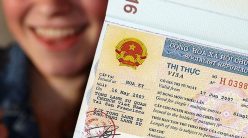Chapter 1: GENERAL ABOUT TRADEMARKS AND GEOGRAPHICAL INSTRUCTIONS (continued)
- Contents of protection, limitation of rights and term of trademark protection
4.1 Contents of protection for trademarks
According to the provisions of Clause 1, Article 123 of the Intellectual Property Law, the owner of a trademark registration has the following basic rights:
Firstly , using and allowing others to use industrial property objects, including the following acts:
“a) Affix the protected mark on goods, goods packaging, means of business, means of service, transaction documents in business activities;
- b) Circulating, offering for sale, advertising for sale, stocking for sale of goods bearing the protected mark;
- c) Importing goods and services bearing the protected mark.”
Second , the right to prevent others from using the mark. Trademark registration owners and organizations and individuals that are granted the right to use the mark have the right to prohibit others from using that mark if such use does not fall into the following cases:
– Circulating, importing, exploiting the uses of products that are put on the market, including foreign markets, in a lawful manner, except for products not registered by the trademark owner or an authorized person of the company. the owner registers the mark to put it on the foreign market;
Use truthfully names of people, signs describing the type, quantity, quality, utility, value, geographical origin and other characteristics of goods and services.
In addition, the law also prohibits individuals and organizations from committing acts of infringing upon the rights of trademark registration owners such as:
“a) Using a sign identical to a protected mark for goods or services identical with goods or services on the list of registered trademarks attached to that mark;
- b) Using a sign identical to a protected mark for goods or services similar to or related to goods or services on the list of registered trademarks attached to such mark, if the use is likely to cause confusion. about the origin of goods and services;
- c) Using a sign similar to a protected mark for goods or services that are identical to, similar to or related to, goods or services on the list of goods or services registered with such mark, if the use is likely the possibility of causing confusion about the origin of goods and services;
- d) Using signs identical or similar to well-known trademarks or signs in the form of translations or transcriptions of well-known marks for any goods or services, including goods or services that are not identical or not. similar and unrelated to goods or services on the list of goods and services bearing the well-known mark, if the use is likely to cause confusion about the origin of the goods or give a false impression about the relationship between them. relationship between the user of that sign and the owner of the well-known mark”.
Third , the right to dispose of the trademark. Within the scope and term of ownership of his/her trademark, the owner has the right to transfer ownership of his/her trademark to another organization or individual. The transfer of trademark ownership includes two forms: the transfer of trademark ownership and the transfer of the right to use the mark.
Transfer of trademark ownership means that the owner of industrial property rights transfers his/her ownership rights to another organization or individual. The transfer of ownership rights to a trademark must be done in the form of a written contract. When transferring a mark, the owner and the transferee of the mark must agree to ensure that the transfer of the right to the mark does not cause confusion about the characteristics and origin of the goods. In addition, ownership of a mark may only be transferred to an organization or individual that meets the conditions for the person having the right to register that mark. Specifically, in the case of transferring a certification mark, the transferee of the certification mark must meet the same requirements and conditions as the owner when registering the certification mark.
Transfer of the right to use a mark means the owner of the mark allows another organization or individual to use the mark within the scope of his/her use right. The transfer of the right to use a trademark must be done in the form of a written contract. The transfer of the right to use a mark is restricted in the following cases: The right to use the collective mark may not be transferred to an organization or individual that is not a member of the owner of that collective mark registration; The licensee may not enter into a secondary contract with a third party, unless otherwise permitted by the licensor; The licensee of the right to use the mark is obliged to write instructions on the goods and packages of goods about the fact that such goods are produced under the contract to use the mark.

Image for illustration purposes only (Internet source)
4.2 Limitation of trademark protection
According to the provisions of Article 132 of the Intellectual Property Law, the factor limiting the ownership of that mark is the obligation to use the mark. Also according to the provisions of Clause 2, Article 136 of the Intellectual Property Law, on the obligation to use trademarks:
“The owner of a trademark registration is obliged to use the mark continuously. In case a mark is not used continuously for five years or more, the ownership of such mark shall be terminated according to the provisions of Article 95 of this Law.”
In addition, the law places some limitations on the transfer of trademark ownership.
With regard to the assignment of trademark ownership, the owner of the exclusive right to register a trademark may only transfer his rights within the protected area. The assignment of rights to a mark must not cause confusion about the characteristics and origin of the goods or services for which the mark is registered. At the same time, the right to a mark may only be transferred to an organization or individual that meets the conditions for the person having the right to register that mark.
For trademark licensing, the Licensee may not enter into a secondary contract with a third party (unless permitted by the licensor) and is obliged to write instructions on the goods and packaging. that the goods are manufactured under a contract to use the mark. In addition, the right to use the collective mark may not be transferred to an organization or individual that is not a member of the owner of that collective mark registration.
4.3 Term of trademark protection
According to the provisions of Clause 6, Article 93 of the Intellectual Property Law, “A certificate of trademark registration is valid from the date of grant to the end of ten years from the date of application, and can be renewed for many consecutive times, each ten five”. Thus, in principle, trademarks can be protected indefinitely. Industrial property rights to marks arising on the basis of international mark registration are protected by the State from the date the international mark registration is published in the International Trademark Gazette of the Intellectual Property Organization. world to the end of the validity period of the international registration under the Madrid Agreement. According to Article 6 of the Madrid Agreement: “Registration of a mark at the International Bureau is valid for 20 years with the possibility of renewal under the conditions specified in Article 7”.
For support and advice on intellectual property issues in the best way, please contact us with the following information:
DHP LAW
Address: L4-09.OT06 Landmark 4 Vinhomes Building Central Park, 720A Dien Bien Phu, Ward 22, Binh Thanh District, Ho Chi Minh City








